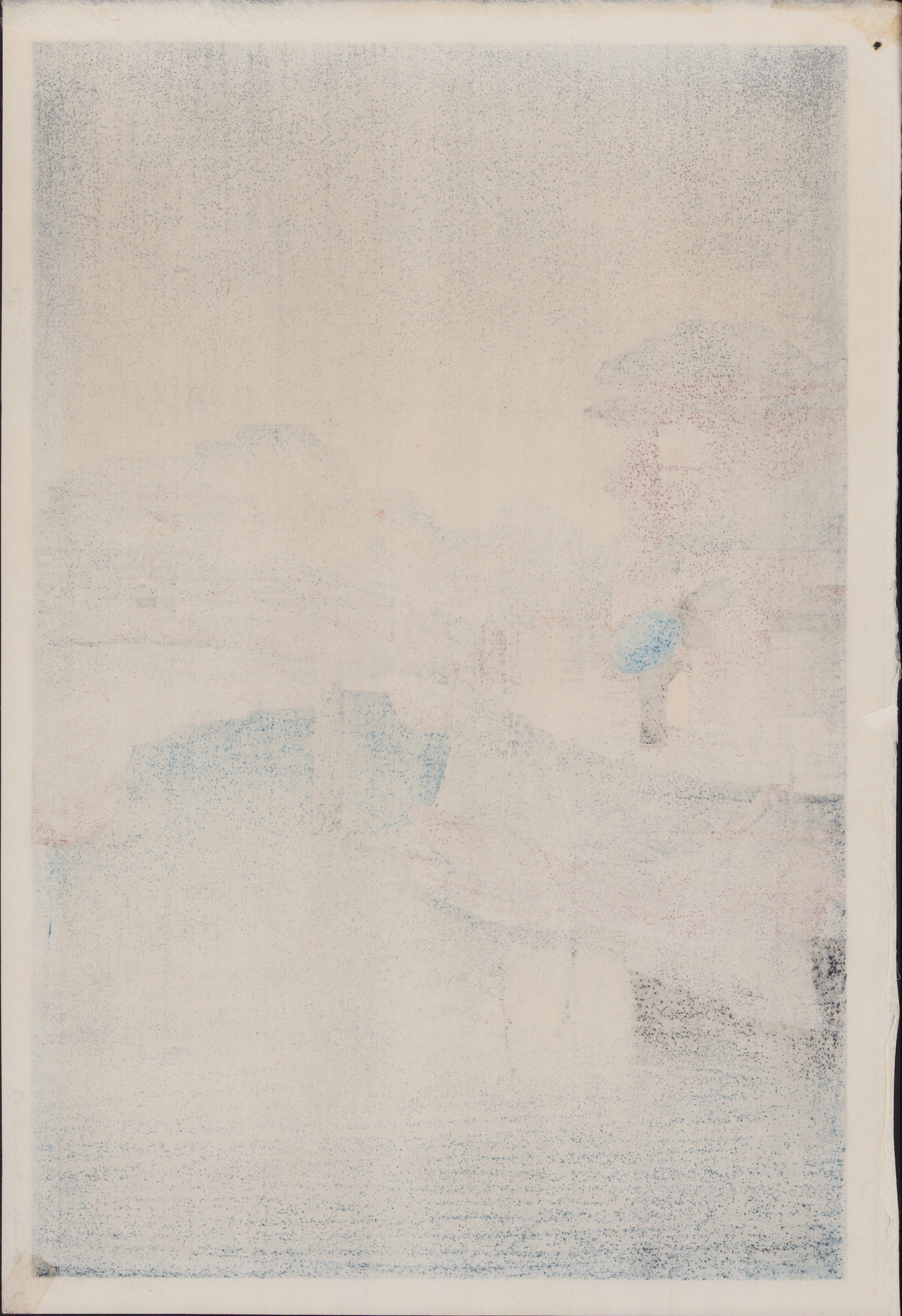Hasui | Shinagawa
川瀨巴水 Kawase Hasui ( 1883–1957)
品川
Shinagawa
1931
木版画 | 纵绘大大判 | 39cm x 26cm
Woodblock-print | Large Oban tate-e | 39cm x 26cm
首次出版1931年;此幅为1946-1957的再次印刷 (巴水在世);品相完好;画面左边边缘有两个小孔;边缘右上角有非常轻微的污渍
Designed 1931; reprinted 1946-1957 (Lifetime); fine condition ; two small binding holes in left margin; slight smudge on right border
$2,900
画面中描绘的是品川某地的雨景,构图是经典的三段式:天、地、水,三者两两相接,并由斜斜的雨丝所联结成了一个整体。不论是灰蒙蒙的天,浅蓝蓝的水,还是木质的房屋、小舟与渡桥,都带给人一种旧时光的暖意。全景最亮眼的那把和伞,就像画的眼睛。又好似海天相接的那一角,忽地落下一滴水,撑开一圈涟漪。巴水西洋留学的经历,使他形成了独特而细腻的东方光影美学,再好好看看桥下荡漾的水纹,桥身在水中的流光倒影,甚至于路面湿滑斑驳的质感吧,那可是由数十次精准且繁复的套色形成的微妙浪漫。
Interested in purchasing?
Please contact us.
川瀨巴水 Kawase Hasui ( 1883–1957)
品川
Shinagawa
1931
木版画 | 纵绘大大判 | 39cm x 26cm
Woodblock-print | Large Oban tate-e | 39cm x 26cm
首次出版1931年;此幅为1946-1957的再次印刷 (巴水在世);品相完好;画面左边边缘有两个小孔;边缘右上角有非常轻微的污渍
Designed 1931; reprinted 1946-1957 (Lifetime); fine condition ; two small binding holes in left margin; slight smudge on right border
$2,900
画面中描绘的是品川某地的雨景,构图是经典的三段式:天、地、水,三者两两相接,并由斜斜的雨丝所联结成了一个整体。不论是灰蒙蒙的天,浅蓝蓝的水,还是木质的房屋、小舟与渡桥,都带给人一种旧时光的暖意。全景最亮眼的那把和伞,就像画的眼睛。又好似海天相接的那一角,忽地落下一滴水,撑开一圈涟漪。巴水西洋留学的经历,使他形成了独特而细腻的东方光影美学,再好好看看桥下荡漾的水纹,桥身在水中的流光倒影,甚至于路面湿滑斑驳的质感吧,那可是由数十次精准且繁复的套色形成的微妙浪漫。
Interested in purchasing?
Please contact us.
川瀨巴水 Kawase Hasui ( 1883–1957)
品川
Shinagawa
1931
木版画 | 纵绘大大判 | 39cm x 26cm
Woodblock-print | Large Oban tate-e | 39cm x 26cm
首次出版1931年;此幅为1946-1957的再次印刷 (巴水在世);品相完好;画面左边边缘有两个小孔;边缘右上角有非常轻微的污渍
Designed 1931; reprinted 1946-1957 (Lifetime); fine condition ; two small binding holes in left margin; slight smudge on right border
$2,900
画面中描绘的是品川某地的雨景,构图是经典的三段式:天、地、水,三者两两相接,并由斜斜的雨丝所联结成了一个整体。不论是灰蒙蒙的天,浅蓝蓝的水,还是木质的房屋、小舟与渡桥,都带给人一种旧时光的暖意。全景最亮眼的那把和伞,就像画的眼睛。又好似海天相接的那一角,忽地落下一滴水,撑开一圈涟漪。巴水西洋留学的经历,使他形成了独特而细腻的东方光影美学,再好好看看桥下荡漾的水纹,桥身在水中的流光倒影,甚至于路面湿滑斑驳的质感吧,那可是由数十次精准且繁复的套色形成的微妙浪漫。
Interested in purchasing?
Please contact us.
Kawase Hasui (1883–1957)
Kawase Hasui is perhaps the single most recognized woodblock artist of the Shin Hanga – new print – movement in the early- to mid-20th Century. Because he specialized in landscapes, many would say he was a successor to Hiroshige, noting his enveloping portrayals of nature, and his thoughtful placement of humans within them. But that would be too easy, because Hiroshige and Hasui in many ways could not be more different.
Whereas Hiroshige played with flat plains of negative space, Hasui embraced Western painting styles – if not techniques – to display water reflections, shadows and shades of light in all its combinations. You can easily discern the time of day and season from the light. Signs of the 20th Century Japan are everywhere – rickshaws, cars, telephone poles, steamships, even western-style umbrellas and rain slickers. Yes, he embraced snow and rain scenes like Hiroshige, and many famous views, but they live in a three-dimensional, modern world.
His prints are hugely sought-after today, with condition being extremely important to collectors. Many of the original woodblocks were destroyed in the Great Earthquake of 1923; finding examples of those pre-quake prints is challenging, indeed.
He was born Bunjiro Kawase in Tokyo in 1883, the son of a merchant. Hasui studied Japanese-style painting with Kiyokata and Western painting at the Hakubakai. He exhibited his first painting at 19. The publisher Shozaburo Watanabe – seeing the appeal of woodblock prints to the Western tourists then flooding Japan – took Hasui under his wing. The young man travelled widely to capture landscapes, making sketches as he went. Looking at the detail and perspective in some of his prints, one wonders: did he work from photographs as well?
Hasui’s Zojoji Temple in Snow – with a man pushing against the furious snow with a traditional umbrella -- has been named an Intangible Cultural Treasure, the greatest artistic honor in postwar Japan. He died in 1957.
The publishers Doi, Kawaguchi, Sakai and others also produced some Hasui works. Learning to read the seals on the prints, and therefore dating them, takes time but is well worth it. If you can find this book at a reasonable price, go for it. It’s all there.


